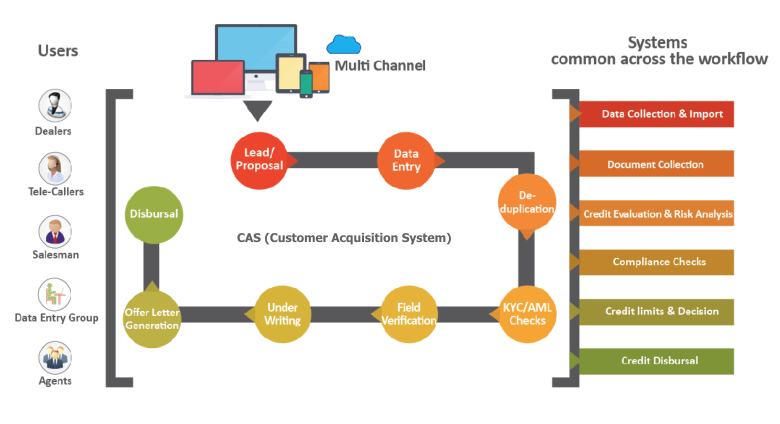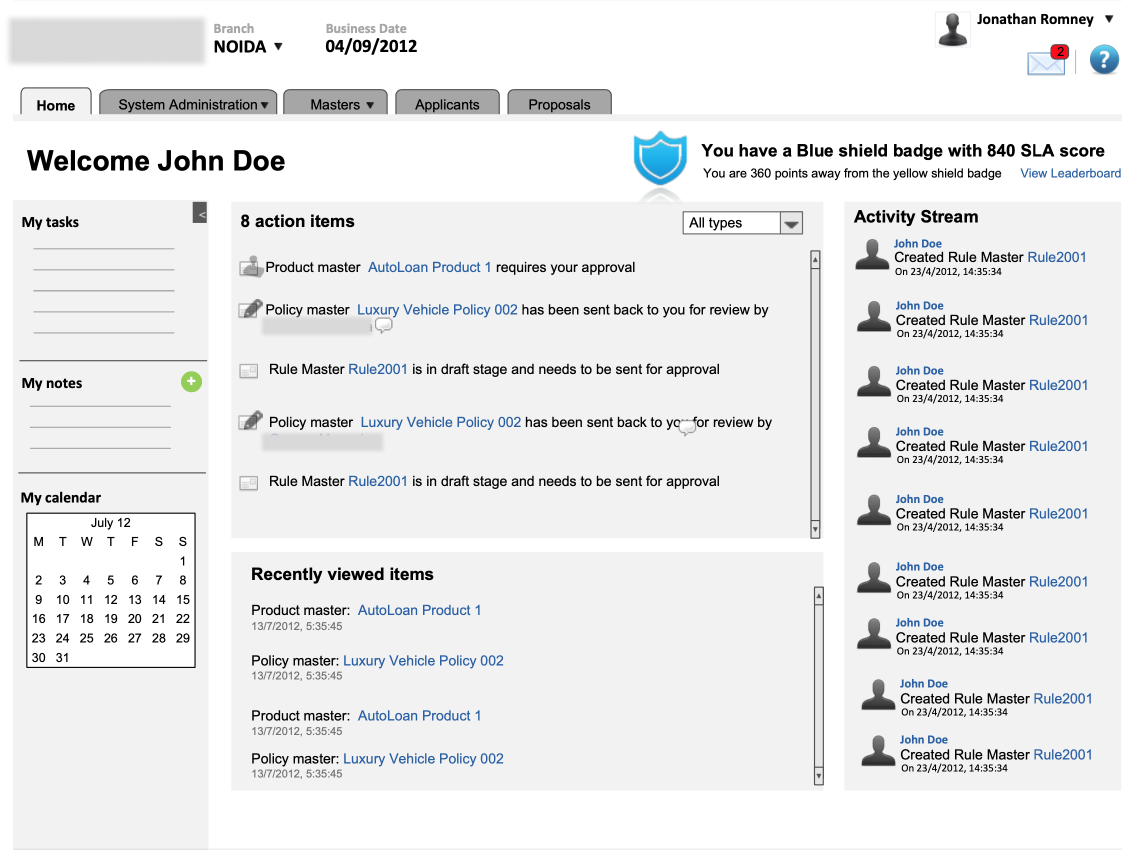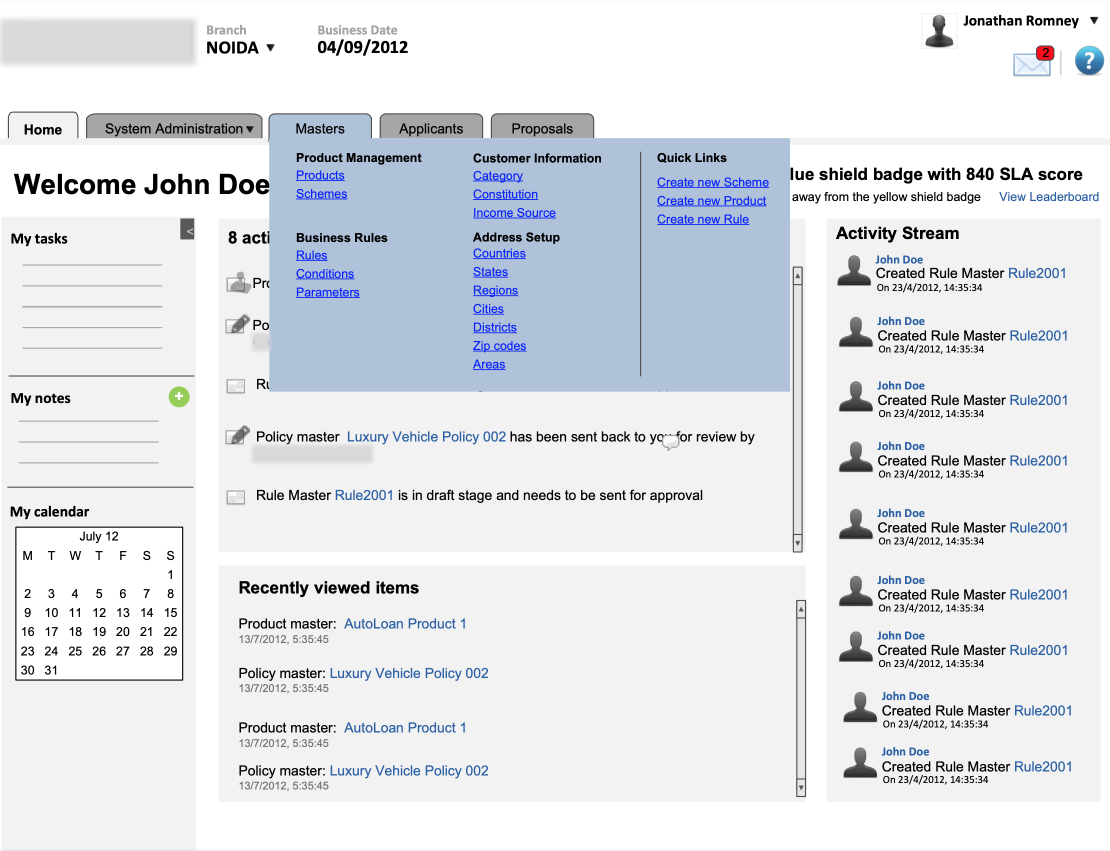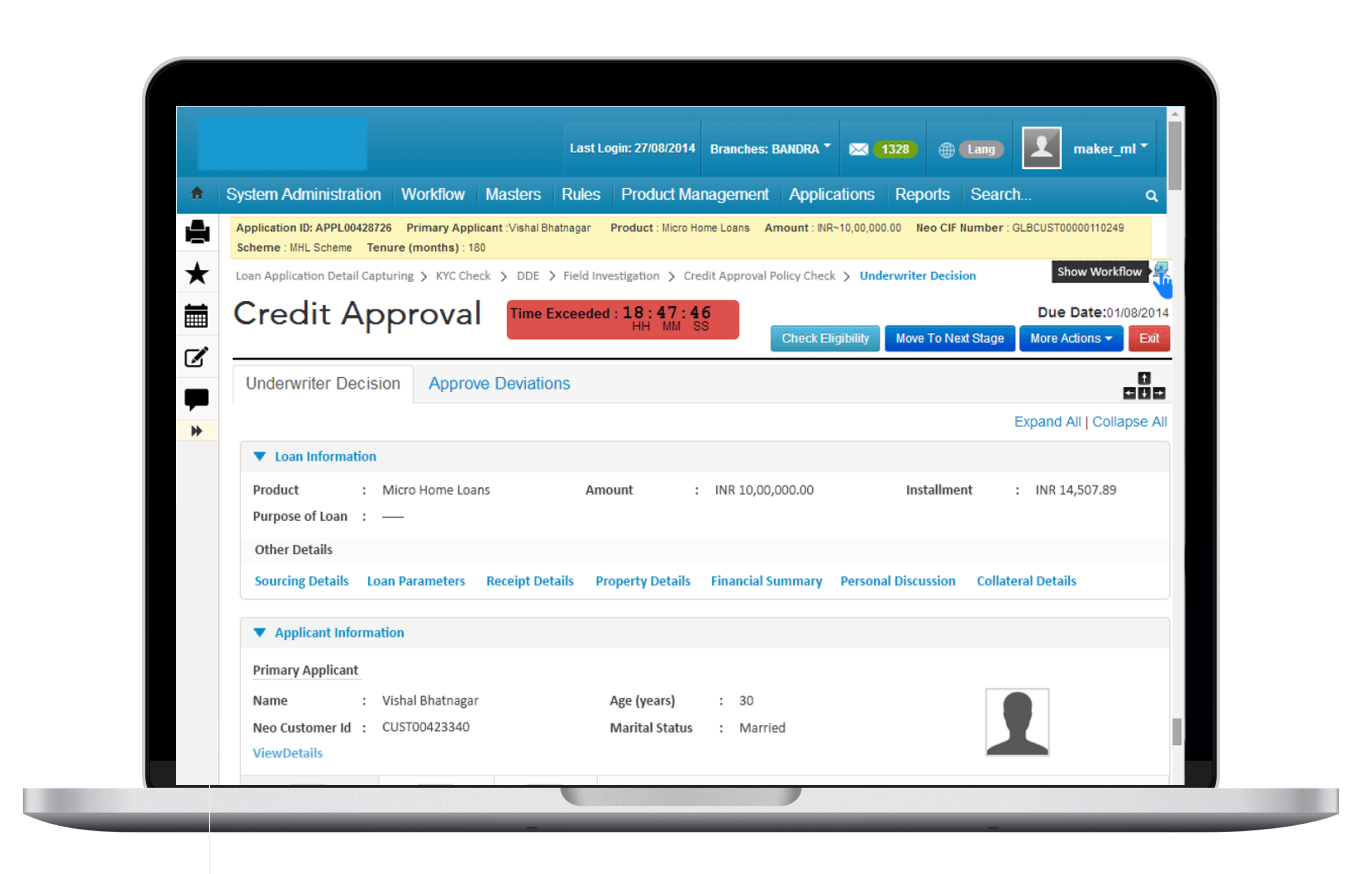NextGen Lending Suite
Designing a unified experience for lending operations — where configurability meets clarity.
🧭 Overview
The project focused on designing a next-generation loan lifecycle management platform for a global financial software company.
The goal was to replace the organization’s legacy banking software with a modern, scalable, and user-friendly platform that could operate seamlessly across web and mobile environments.
The new product was envisioned as a unified digital ecosystem to manage every aspect of the lending journey — from customer acquisition to loan servicing and collections — while supporting global deployments with multi-currency and multi-lingual features.
🧩 Problem Statement
Legacy banking systems were complex, slow, and visually inconsistent. They lacked cross-platform compatibility and forced users to navigate through redundant workflows.
Financial institutions needed a smarter, more intuitive lending platform that could adapt to regulatory, market, and technological shifts — without overhauling their core systems.
🎯 Project Objectives
- Develop a modular, scalable lending platform for multi-branch and multi-tenant use.
- Design a responsive, device-agnostic user interface for web, tablet, and mobile.
- Streamline the end-to-end loan process — from lead acquisition to disbursal.
- Build a consistent UI system that could be customized for different banks and regions.
- Enable faster onboarding and reduced training time through better UX clarity.
👥 Role & Contributions
Role: UX Designer & UI Developer
Team: Cross-functional team of Product Owners, Business Analysts, Developers, QA, and UX Designers.
Duration: 2+ years (Core Product Build Phase)
Key Contributions:
- Co-formed the UX Design Team within the organization, setting foundations for user-centered design.
- Worked as Designer (UX) and Developer (UI), bridging the gap between design intent and implementation.
- Assisted in Information Architecture, Interaction, and Visual Design of the core business modules.
- Acted as a catalyst for UCD (User-Centered Design) awareness across product and engineering teams.
- Conceptualized the mobile app for field officers, enabling on-the-go loan sourcing and verification.
- Supported desktop, tablet, and multi-browser responsive design for wider accessibility.
- Witnessed and contributed to the entire product evolution — from concept to global rollout.
- Designed team branding and merchandise (t-shirt) to boost morale and foster identity during the build phase.
🧠 UX Vision
To simplify complex financial workflows through clarity, consistency, and confidence.
The vision centered on enabling banking teams to perform faster, smarter, and more efficiently — regardless of device or location.
Design Philosophy:
- Break long workflows into short, meaningful tasks.
- Use progressive disclosure to avoid cognitive overload.
- Prioritize flow and feedback over visual decoration.
- Build with modularity and scalability for future updates.
🧱 Core Modules
- Customer Acquisition System (CAS) – Lead management, credit evaluation, document verification.
- Loan Management System (LMS) – Loan servicing, payments, and modifications.
- Collections Module – Tracking delinquency and managing recovery actions.
- Finance Against Securities (FAS) – Lending against financial instruments.
- Advanced Analytics – Predictive dashboards and customer insights.
- Mobility Suite – Field officer app for sourcing, underwriting, and collections.
🔍 Discovery & Research
Methods
- Contextual interviews with loan officers, underwriters, and operations staff.
- Heuristic evaluation of existing systems.
- Process mapping workshops with product and compliance teams.
- Competitor benchmarking of leading digital lending tools.
- Defined proto-personas for multiple user roles (Underwriter, Sales Officer, Branch Admin).
Key Findings
| Insight | Problem | UX Opportunity |
|---|---|---|
| Manual decisioning slowed loan approval | Siloed components | Introduce visual rule configuration and scoring |
| Long, linear workflows | No real-time visibility | Create stage-based workflow tracking |
| High training dependency | Complex UI with jargon | Simplify terminology, use guided onboarding |
| Lack of role clarity | Shared dashboards | Build role-based home screens |
💡 Insights
- 80% of tasks revolved around only 20% of features — prioritize core workflows.
- Users trusted visual confirmations (color, icons, states) more than system alerts.
- A single-page summary view for each customer reduced cognitive load drastically.
- Cross-department collaboration improved when workflows were visually represented.
👤 Proto-Personas
1. The Field Officer
Role: Sales / Customer Acquisition (Mobile-first user)
Age Range: 25–35
Tech Comfort: Medium
Device Preference: Smartphone, Tablet
Goals:
- Capture and process loan leads quickly while on the field.
- Reduce manual paperwork and repetitive data entry.
- Access applicant information and credit history instantly.
- Complete verification and approvals remotely.
Frustrations:
- Slow, non-responsive legacy tools.
- Connectivity issues and data sync delays.
- Redundant input fields causing rework.
- Lack of visibility on application status post-submission.
Motivations:
- Wants to close more applications per day.
- Appreciates tools that save time and make customers happy.
- Values quick, clear feedback from the system.
Key UX Needs:
- Simple mobile UI with offline capability.
- Auto-filled forms and pre-validated fields.
- Status tracking and push notifications.
- Seamless integration with CRM and back-office systems.
2. The Underwriter / Credit Analyst
Role: Risk and Credit Decisioning
Age Range: 30–45
Tech Comfort: High
Device Preference: Desktop / Dual Monitors / Multidevice
Goals:
- Evaluate loan applications efficiently with complete visibility into applicant data.
- Ensure compliance with credit and risk policies.
- Minimize manual effort through automation and intelligent rule engines.
Frustrations:
- Overloaded forms with unstructured data.
- Switching between multiple systems for validation and scoring.
- Delays in document verification due to poor workflow design.
Motivations:
- Wants a reliable, accurate decision-support system.
- Prefers a clean dashboard with contextual insights.
- Seeks confidence that decisions are backed by data.
Key UX Needs:
- Smart dashboards with predictive scoring and alerts.
- Consolidated credit evaluation screens.
- Intuitive navigation between leads, documents, and policy checks.
- Clear audit trail and version control for regulatory compliance.
3. The Operations Manager / Branch Admin
Role: Supervises loan processing and overall branch operations
Age Range: 35–50
Tech Comfort: Moderate
Device Preference: Desktop / Tablet
Goals:
- Monitor daily loan applications, approvals, and disbursals.
- Track team productivity and identify process bottlenecks.
- Access real-time reports and compliance metrics.
Frustrations:
- Difficulty in accessing consolidated reports across branches.
- Lack of visibility on application progress.
- Dependency on IT or analysts for performance data.
Motivations:
- Wants to make data-driven decisions quickly.
- Needs a sense of control over operations and reporting.
- Aims to maintain compliance and ensure branch-level efficiency.
Key UX Needs:
- Centralized dashboard with KPIs and filters.
- Customizable reports and export options.
- Visual indicators for exceptions and pending actions.
- Responsive design for on-the-go access.
💡 Persona Insights Summary
- Each persona experiences the same loan lifecycle from different perspectives — capture, evaluate, manage, monitor.
- The design approach focused on role-based interfaces, allowing each persona to focus on what matters most to them.
- Simplification increased confidence — users preferred step-by-step workflows over dense forms.
- Status visibility and contextual guidance significantly reduced operational errors.
- Consistent UI patterns enhanced cross-branch collaboration and reduced training time.
- Design in Browser approach ensured faster turnaround and real-world validation during product development phase.
🧭 UX Design Strategy
To address both complexity and flexibility, the UX was built around four strategic pillars:
| Pillar | Focus | UX Approach |
|---|---|---|
| Credit Decisioning | Automate rule-based approvals | Create scoring visualization & configurable rule templates |
| Workflows | Ensure traceability & flexibility | Visual workflow editor + progress tracker |
| Usability & Customization | Reduce dependency on dev teams | Widget-based layout builder & theming |
| Security & Integration | Build trust through transparency | Visual feedback for authentication & API sync |
and other approaches as summarized below:
- Adopted Agile UX — design sprints ran 2–3 cycles ahead of development.
- Emphasized Build → Measure → Learn → Repeat as the core process.
- Used modular task flows to minimize screen clutter and decision fatigue.
- Adding learnings from repeated usability test & validations during product demos.
- Created reusable UI widgets for consistency and faster development cycles.
🗺️ Information Architecture
- Consolidated scattered modules into role-based dashboards.
- Defined clear navigation hierarchies for different user personas.
- Introduced search-driven actions and context-sensitive toolbars.
- Designed scalable layouts adaptable for multiple devices and languages.
🎨 Design System: NEON
- Developed a modular, atomic design system with reusable components.
- Created customizable color palettes for white-labeled bank implementations.
- Established UI guidelines, typography scales, and form behavior patterns.
- Maintained version-controlled UI libraries for ongoing releases.
✏️ Wireframes & Prototyping
- Initial ideas as sketches → digital wireframes → interactive prototypes.
- Validation with business analysts and regional leads.
- Developed high-fidelity mockups for cross-device views (desktop, tablet, mobile).
- Shared prototypes using internal collaboration tools for feedback cycles.
⚙️ Key UX Features
- Adaptive workflows for multi-branch configurations.
- Dashboards for risk and credit analysis.
- Smart validation and rule engine for compliance automation.
- Dark/light UI themes to improve user comfort.
- Dynamic forms with inline feedback for real-time error correction.
- Optimized experience for different bandwidth usage
🧪 Usability Testing
- Conducted iterative usability tests with internal banking teams.
- Metrics tracked:
- Task success rate
- Error frequency
- Task completion time
- Post-testing refinements improved operational efficiency by 30–40%.
- Validations informed final adjustments in navigation and workflow simplification.
📈 Business Impact
- Reduced loan processing time through streamlined workflows.
- Improved time-to-market for new lending products.
- Enhanced user satisfaction across bank branches.
- Accelerated adoption in international markets due to localization support.
- Established a reusable design framework for future banking modules.
- Enhanced brand image and market positioning with the launch of the lending suite.
- Provided a universal UX blueprint to be reused for multiple global clients.
💬 Learnings
- Bridging UX and UI roles enhances product alignment.
- Early stakeholder validation prevents major redesign cycles.
- Promoting user-centered design culture is as critical as delivering the product itself.
- Modular design accelerates scalability in enterprise systems.
- Having strong conviction in the ideas & dream despite of relentless struggle in a massive product devlopment paves the way for success.
✨ Conclusion
Designing this enterprise lending platform was a deep dive into complex systems UX —
where financial precision, regulatory compliance, and human usability had to coexist harmoniously.
Through strategic design systems, adaptive workflows, and empathetic user research,
we transformed a dense enterprise tool into a configurable, human-centered financial experience.




